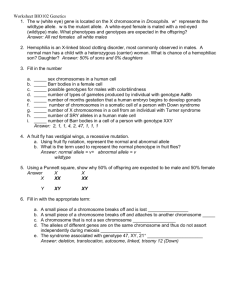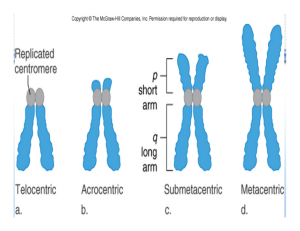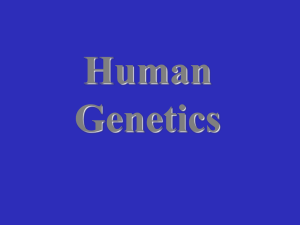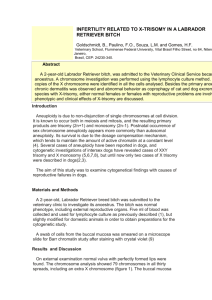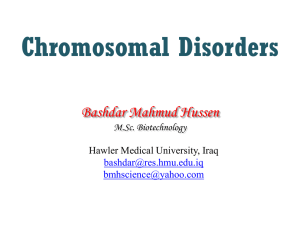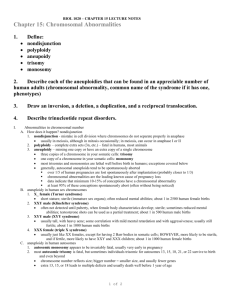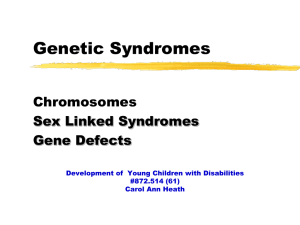Genetics 105-113 [4-20
advertisement
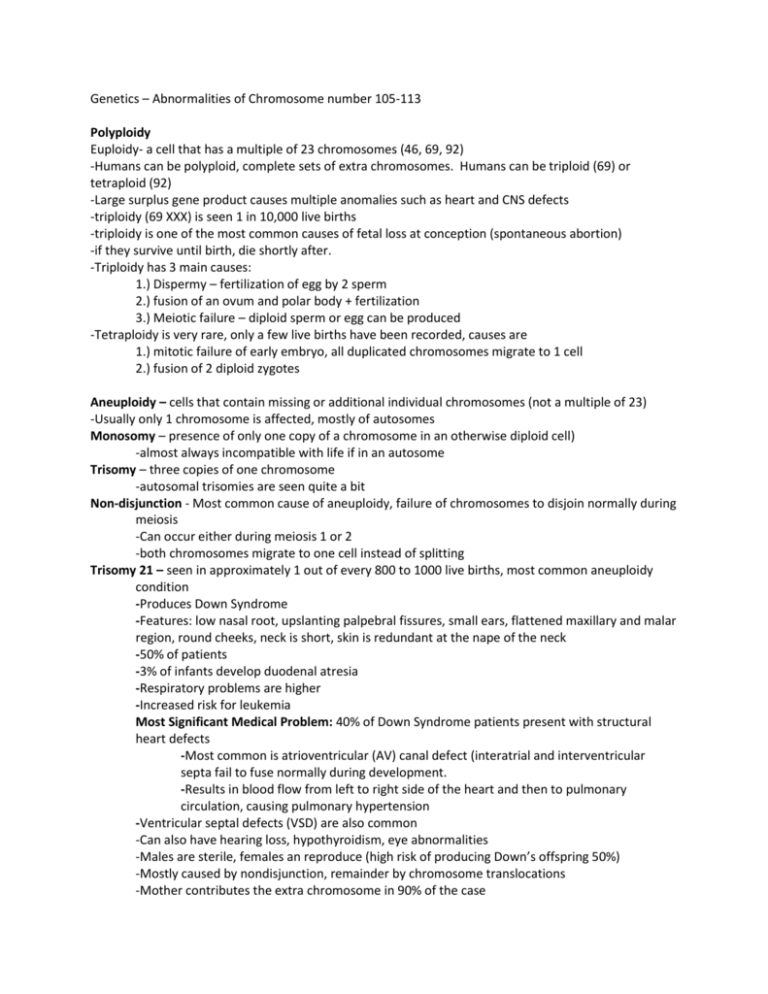
Genetics – Abnormalities of Chromosome number 105-113 Polyploidy Euploidy- a cell that has a multiple of 23 chromosomes (46, 69, 92) -Humans can be polyploid, complete sets of extra chromosomes. Humans can be triploid (69) or tetraploid (92) -Large surplus gene product causes multiple anomalies such as heart and CNS defects -triploidy (69 XXX) is seen 1 in 10,000 live births -triploidy is one of the most common causes of fetal loss at conception (spontaneous abortion) -if they survive until birth, die shortly after. -Triploidy has 3 main causes: 1.) Dispermy – fertilization of egg by 2 sperm 2.) fusion of an ovum and polar body + fertilization 3.) Meiotic failure – diploid sperm or egg can be produced -Tetraploidy is very rare, only a few live births have been recorded, causes are 1.) mitotic failure of early embryo, all duplicated chromosomes migrate to 1 cell 2.) fusion of 2 diploid zygotes Aneuploidy – cells that contain missing or additional individual chromosomes (not a multiple of 23) -Usually only 1 chromosome is affected, mostly of autosomes Monosomy – presence of only one copy of a chromosome in an otherwise diploid cell) -almost always incompatible with life if in an autosome Trisomy – three copies of one chromosome -autosomal trisomies are seen quite a bit Non-disjunction - Most common cause of aneuploidy, failure of chromosomes to disjoin normally during meiosis -Can occur either during meiosis 1 or 2 -both chromosomes migrate to one cell instead of splitting Trisomy 21 – seen in approximately 1 out of every 800 to 1000 live births, most common aneuploidy condition -Produces Down Syndrome -Features: low nasal root, upslanting palpebral fissures, small ears, flattened maxillary and malar region, round cheeks, neck is short, skin is redundant at the nape of the neck -50% of patients -3% of infants develop duodenal atresia -Respiratory problems are higher -Increased risk for leukemia Most Significant Medical Problem: 40% of Down Syndrome patients present with structural heart defects -Most common is atrioventricular (AV) canal defect (interatrial and interventricular septa fail to fuse normally during development. -Results in blood flow from left to right side of the heart and then to pulmonary circulation, causing pulmonary hypertension -Ventricular septal defects (VSD) are also common -Can also have hearing loss, hypothyroidism, eye abnormalities -Males are sterile, females an reproduce (high risk of producing Down’s offspring 50%) -Mostly caused by nondisjunction, remainder by chromosome translocations -Mother contributes the extra chromosome in 90% of the case -Mosaicism- Patients with some normal somatic cells and other cells with trisomy 21. -Nomenclature: 47, XY + 21[10]/46, XY[10] (number in brackets indicate cells counted with the Down’s karyotype -Most common cause is trisomic conception followed by loss of the extra chromosome during mitosis in some embryonic cells -results in milder clinical symptoms Tissue-specific mosaicism – mosaicism confined only to certain tissues -mosaicism in germline of parent causes recurrent risk for Down Syndrome in patients -Candidate gene for mental retardation in Down’s Patients is DYRK1A, a kinase gene that causes learning and memory defects when overexpressed in mice -Another candidate gene is APP (amyloid B precursor protein), a 3rd copy of APP in a trisomy 21 patient accounts for the Alzheimer’s symptoms seen in nearly all Down’s patients by age 40. -Partial trisomies not affecting the APP region do not produce alzheimer’s symptoms. Trisomy 18 – Also known as Edwards Syndrome, second most common trisomy (1:6000 live births) -most common chromosomal abnormality among stillborns -prenatal growth deficiency, characteristic facial features, and a distinctive hand abnormality (index finger on top of middle finger) -Congenital heart defects (VSD) are most common in 90% of children -Omphalocele – protrusion of bowel into umbilical cord -Radial Aplasia – missing radius bone -Diaphragmatic hernia, and spina bifida -50% of infants with trisomy 18 die within the first several weeks of life -aspiration pneumonia, predisposition to infections, heart defects account for mortality. -developmental abnormalities – children not able to walk independently. -very little mosaicism, mostly complete trisomy. -Nondisjunction of maternal chromosome 18 in 90% of all cases Trisomy 13 – also called Patau Syndrome, seen 1:10000 live births, 95% of infants die within first year of life -oral/facial clefts, micropthalmia (small eyes), polydactyly -CNS malformations -Heart defects -Renal anomalies -Cutis aplasia (scalp defect on posterior occiput) -Can progress in development to communicate with parents, unlike trisomy 18 -80% of Patau syndrome patients have complete trisomy, with the other 20% having a translocation of the long arm of chromosome 13 -95% of Patau patients spontaneously lost during pregnancy Nondisjunction Risk and Maternal Age – Less than 30 years – 1/1000 35 years - 1/400 40 years -1/100 45 years -1/25 -the older the woman, the older her ova are, since they are arrested in prophase until ovulation. Environmental factors (smoking, alcohol consumption, and radiation can play a role) Turner Syndrome – phenotype associated with sex chromosome aneuploidy of a single X chromosome (45X) -usually female with the following characteristics: -short stature -sexual infantilism, ovarian dysgenesis (streaks of connective tissue seen instead of ovaries) -major and minor malformations -triangle shaped face, webbed neck, chest is broad and shield-like -lymphedema of hands and feet -congenital heart defects – most commonly obstructive lesions on left side of heart (bicuspid aortic valve in 50% of patients) -50% of patients have kidney defects -50% of patients have 45,X karyotype, 30-40% of patients have 45,X/46,XX and less commonly 45,X/46,XY -10% of patients have structural X chromosome abnormalities involving deletion of some or all of XP. -60-80% of cases involve loss of paternal X chromosome, occurring either in mitosis of embryo or early meiosis of father -1-2% of all conceptions are 45,X, but the low number of births with 45,X (1:1000) suggests majority are lost prenatally. -many survivors are mosaics, or placental mosaics (of placenta alone) -mutations in SHOX gene, which encodes transcription factor for embryonic limbs, produces short stature, thought to be associated with Turner’s Phenotype -located on distal tip of X and Y short arms (escaping inactivation), thus 2 copies are normally transcribed, Turner’s patients would only have one copy transcribed, resulting in haploinsufficiency -Pseudoautosomal Region: During normal meiosis, crossover occurs between tip of short arm of Y chromosome and tip of short arm of X chromosome. These regions have homology, and therefore behave similar to autosomes. Distal portion of Y chromosome is called Pseudoautosomal region -SRY gene is just proximal to pseudoautosomal region (determines male phenotype) -Acts antagonistically against DAX1, which normally represses differentiation of embryo into a male -absence of SRY causes DAX1 to act unopposed, producing females -males produced when SRY upregulates SOX9 Klinefelter Syndrome (47, XXY) – 1/500 to 1/1000 births -primary cause of hypogonadism in males -taller than average, sterile, testosterone levels are low -Gynecomastia is common (breast development) -reduction in verbal IQ -Extra chromosome is mostly derived maternally, and mosaicism can be seen in 15% of patients -Can also be XXXY and XXXXY – degree of mental and physical deficiency increases with more X’s -Can be treated with testosterone therapy Trisomy X (47, XXX) – 1/1000 females, benign consequences, sometimes suffering from sterility, menstrual irregularity, mild mental retardation, can be found with XXXX or XXXXX 47, XXY Syndrome – males with this karyotype tend to be taller, lower IQ, few physical irregularities, found with high prevalence in prisons, minor behavioral disorders, hyperactivity, ADD< and learning disabilities





